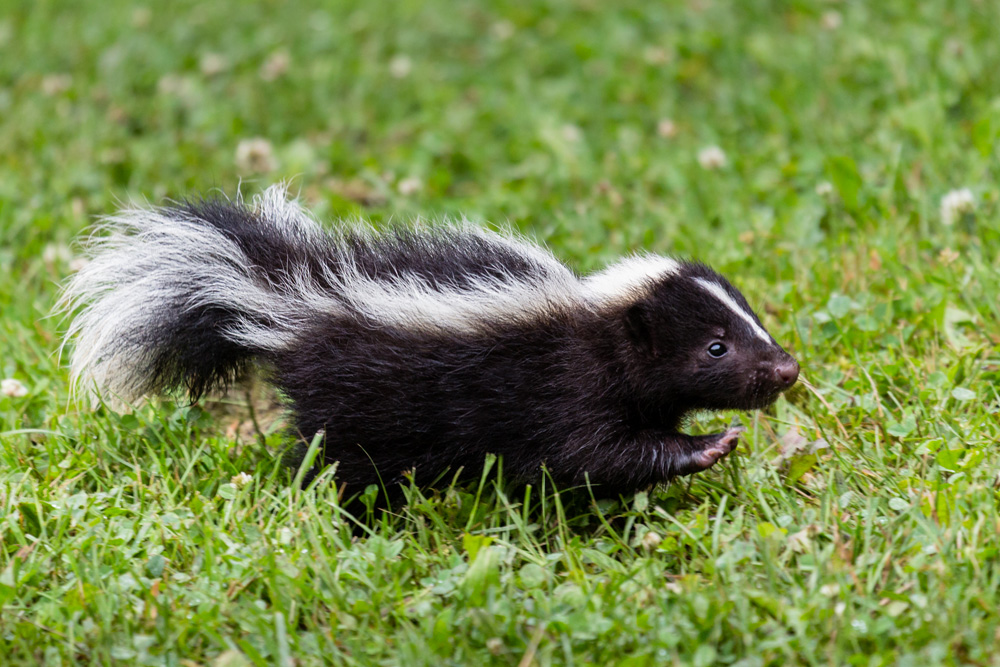To get a skunk out of your garage, gently open the door and use a light to guide it out. Stay calm and avoid sudden movements to prevent spraying.
Discovering a skunk in your garage can be a startling experience. These creatures, while generally non-aggressive, carry a notorious defense mechanism that can leave a lasting impression on your space. Homeowners often find themselves unprepared for such encounters, leading to panic and potential mishaps.
The key to resolving this situation lies in patience and understanding the skunk’s behavior. With the right approach, you can encourage the skunk to leave without any fuss or unwanted odors. This guide offers a straightforward method to safely and effectively remove a skunk from your garage, ensuring peace returns to your home.
The Skunk Dilemma: A Surprise Visitor
Encountering a skunk in the garage can be an unexpected challenge. The presence of this black and white critter can cause alarm and pose a unique dilemma. Without the right approach, the situation could escalate, leading to unpleasant odors or even health risks. Understanding the correct steps to guide this surprise visitor out is crucial.
Initial Reactions
Stay calm and avoid sudden movements. Skunks spray when threatened. Gently open the garage door to provide an exit path. Turn off bright lights; skunks prefer to move in the dark. Be patient, as it may take time for the skunk to leave.
Potential Risks
Skunks carry diseases like rabies. Their spray causes eye irritation and lasting odor. If bitten or sprayed, seek medical attention immediately. Protect pets by keeping them away. Ensure no direct interaction occurs to minimize these risks.

Credit: www.youtube.com
Identifying The Intruder
Discovering an uninvited guest in your garage can be startling. Identifying the intruder correctly is the first step. Skunks are notorious for taking refuge in residential areas. Below, learn how to spot a skunk by its distinctive traits and behaviors.
Physical Characteristics
- Size: About the size of a house cat.
- Fur: Black with white stripes or spots.
- Tail: Bushy, often raised when threatened.
- Nose: Pointed, with a keen sense of smell.
Behavioral Signs
Skunks are mostly nocturnal and non-aggressive. Look for these signs:
| Behavior | Description |
|---|---|
| Digging | Holes in the ground or garbage strewn about. |
| Odor | A strong, musky scent lingers. |
| Tracks | Five-toed footprints, often with claw marks. |
Spotting these signs means a skunk may be near. Stay calm and proceed with caution.
Safety First: Preparing To Take Action
Discovering a skunk in your garage can be startling. Safety is paramount. Before attempting to remove the skunk, equip yourself with the right gear. Ensure the safety of everyone in the vicinity.
Protective Gear
Don proper protective gear to minimize the risk of skunk spray and bites. This gear includes:
- Gloves: Thick gloves protect hands from bites.
- Goggles: Safety goggles shield eyes from spray.
- Clothing: Wear long sleeves and pants to cover skin.
- Mask: A mask can help reduce the smell impact.
Securing Pets And Children
Children and pets are curious. Their safety is crucial. Follow these steps:
- Keep children indoors, away from the garage.
- Place pets in a secure room or their crates.
- Inform everyone about the skunk situation.
Natural Deterrents: Encouraging A Self-exit
Discovering a skunk in your garage can be a shock. The smell alone is enough to send anyone running. But, there’s a gentle way to encourage these black and white visitors to leave. This method does not harm the skunk. It uses natural deterrents to make them choose to exit. Let’s explore how light, noise, and home remedies can be your allies in this task.
Light And Noise
Skunks are nocturnal animals. They avoid light and noise. These can be used to your advantage. Here’s how:
- Keep the garage well-lit at night. Use bright lights.
- Turn on a radio. Choose a talk station. The human voice is more effective.
- Place a motion-activated light or sound device. It surprises them into leaving.
Home Remedies
Natural smells and substances can also encourage a skunk to leave. Try these:
- Place ammonia-soaked rags near the entrance. Skunks dislike the smell.
- Spread cayenne pepper around the garage. It irritates their senses.
- Use a DIY repellent. Mix water, dish soap, and castor oil. Spray around.
Remember, patience is key. These natural deterrents make the skunk choose to leave on its own. No harm comes to the animal. This approach is safe, humane, and effective. Keep children and pets away during the process. Ensure the garage remains a no-go zone for skunks in the future.
The Patience Game: Waiting It Out
When To Observe Signs Of Departure
Keep an eye out for skunk activity during dusk or dawn.
Look for signs like a decrease in noise and scent.
Patience Is Key
Remember, skunks are nocturnal, so be patient.
Wait until the evening for the skunk to leave.
Be calm and avoid loud noises or sudden movements.

Credit: www.aaanimalcontrol.com
Hands-on Methods: Gentle Persuasion
Encountering a skunk in your garage can be alarming. You want to remove it without causing stress or harm. The Hands-On Methods: Gentle Persuasion offer safe techniques to encourage the skunk to leave peacefully. Follow these steps to create a stress-free environment for both you and the skunk.
Using A Broom
Start with a simple broom. Approach the skunk calmly. Keep a safe distance to avoid scaring it. Gently tap the floor with the broom to guide the skunk towards the exit. This non-threatening method often works.
Setting Up A Barrier
Create a path leading out of the garage. Use boards or large boxes to form a barrier. This guides the skunk to the exit without confusion. Ensure the path is clear and the exit is obvious. Patience is key as the skunk finds its way out.
Bait And Trap: Humane Capture
Safely remove a skunk from your garage using humane bait and trap methods. Ensure minimal stress for the animal while protecting your space.
Choosing The Right Trap
Consider live traps for safe skunk capture.
Opt for a trap with a door that closes securely.
Bait Selection
Use smelly bait like canned fish to attract skunks.
Place bait at the back of the trap for best results.
When dealing with a skunk in your garage, a humane approach to capture is essential. Bait and trap methods can effectively remove the skunk without harm.
Choosing The Right Trap
Consider live traps for safe skunk capture.
Opt for a trap with a door that closes securely.
Bait Selection
Use smelly bait like canned fish to attract skunks.
Place bait at the back of the trap for best results.

Credit: www.hgtv.ca
Aftermath: Cleaning Up And Prevention
Evicting a skunk from your garage is relief. The scent lingers though. Securing your garage prevents future skunk visits. This guide helps you clean and safeguard your space.
Deodorizing The Area
Skunk spray is pungent and stubborn. Start by airing out the space. Open doors and windows. Use fans to circulate air. Wear gloves and masks for protection.
Vinegar and baking soda work well for natural cleaning. Mix them into a paste. Apply to affected surfaces. Let it sit. Rinse thoroughly.
For fabrics, wash them multiple times. Use laundry detergent. Add baking soda to boost cleaning power. Check for scent before drying.
Commercial deodorizers are available. Choose products designed for skunk odors. Follow instructions carefully. Test on small areas first.
Sealing Entry Points
Prevention is key. Inspect your garage thoroughly. Look for holes, cracks, and gaps. Skunks can enter through small spaces.
- Fill small holes with caulk.
- Fix broken panels and siding.
- Install door sweeps to block gaps.
Cover vents with wire mesh. Ensure it’s sturdy. Skunks can chew through weak barriers.
Maintain cleanliness. Secure garbage cans. Skunks look for food. Don’t attract them with easy meals.
By deodorizing and sealing your garage, you create a fresh, skunk-free environment. Regular checks and maintenance keep it secure.
Professional Help: When To Call The Experts
Skunks are notorious for their defensive spray. Dealing with these creatures often requires expertise. Certain situations demand professional wildlife removal services. This is when DIY remedies fall short. Safety concerns and local laws dictate the need for experts. Let’s explore when and how to seek help.
Criteria For Professional Help
- Repeated Skunk Encounters: Frequent skunk visits indicate a bigger problem.
- Skunk Babies: A mother skunk and her babies require careful handling.
- Legal Restrictions: Some areas have strict laws on wildlife handling.
- Safety Risk: Skunks can carry diseases, posing a health risk.
- Property Damage: Extensive damage may need professional assessment.
Selecting A Wildlife Removal Service
Choose a wildlife removal service wisely. Look for licensed professionals. They should respect animal welfare laws. Experience in skunk removal is crucial. Check for positive reviews and reasonable rates. Ensure they offer humane removal methods.
| Criteria | Why It Matters |
|---|---|
| License and Insurance | Confirms legitimacy and covers potential damages. |
| Experience | Indicates expertise in skunk behavior and removal techniques. |
| Reviews | Reflects service quality and customer satisfaction. |
| Cost | Should align with the service quality and market rates. |
| Humane Practices | Ensures ethical treatment of animals during removal. |
Legal Considerations: Know The Regulations
Legal Considerations: Know the Regulations when dealing with skunks in your garage. The process is not just about removal. It’s about following the law. Before taking action, understand the legal framework. This ensures humane treatment of the skunk and keeps you within legal boundaries.
State And Local Laws
Laws vary by location. Some areas protect skunks under wildlife regulations. Others categorize them as pests. Check with your state’s wildlife agency. They provide specific guidelines on skunk handling. Illegal actions can lead to fines. Always stay informed and compliant.
Relocation Ethics
Relocating skunks requires careful consideration. Skunks rely on familiar territories for survival. Relocation can harm their chances. It can also disrupt local ecosystems. Consult professionals. They ensure ethical and safe relocation. Respect wildlife and act responsibly.
Frequently Asked Questions
What Attracts Skunks To Garages?
Skunks often seek shelter in garages drawn by accessible food sources, like garbage or pet food, and the safety from predators.
How Can You Prevent Skunks From Entering?
Seal all entry points, secure trash cans, and remove food sources to make your garage less inviting to skunks.
What Are Safe Methods To Remove Skunks?
Use bright lights, gentle noise, or scent deterrents to encourage skunks to leave without harming them.
Can Mothballs Repel Skunks Effectively?
Mothballs may deter skunks due to their strong odor, but they should be used cautiously as they are toxic.
When Should I Call A Professional For Skunks?
If DIY methods fail or you’re concerned for safety, contact a wildlife removal expert to handle the skunk problem.
Conclusion
Dealing with an uninvited skunk can be daunting, but it’s manageable with the right approach. Remember, patience and caution are key to safely removing your stripe-tailed guest. Follow the steps outlined, and your garage will soon be skunk-free. For persistent wildlife issues, consider professional help to keep your space secure and odorless.



